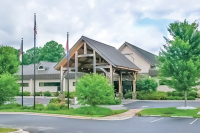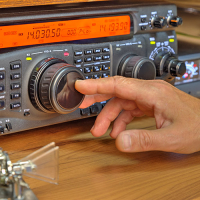It’s hornets vs. swans in OLF controversy
One would think swans would probably be a sure bet in such a scenario. After all, they are bigger and stronger. But these aren’t your average hornets. These are Navy F/A-18 Super Hornet jet fighters.
The Navy appears determined to build outlying landing fields (OLF) in Washington County and/or Hyde County in eastern North Carolina, where their Hornets and jets from Cherry Point Marine Corps Air Station could simulate military maneuvers like nighttime carrier landings. The Navy contends its old practice field, Fentress Auxiliary Landing Field in Chesapeake, is no longer suitable because there is too much light pollution from surrounding development.
So the Navy has decided to move to the country, where it’s dark and peaceful and there are no distractions, except maybe a couple hundred thousand waterfowl and shorebirds, and a few hundred farmers who would have to part with about 30,000 acres of farmland. Other opposition groups include grassroots organizations like North Carolinians Opposed to Outlying Landing Field and their allies which include a myriad of environmental organizations like Audubon, Ducks Unlimited, The Nature Conservancy; farm organizations like the North Carolina Farm Bureau; local governments; and several federal, state and regional agencies. The Navy’s preferred site is in Washington County, just five miles from Pocosin Lakes Refuge, and a preferred alternative is in Hyde County near Mattamuskeet National Wildlife Refuge.
The contest was sent to overtime back in 2003 when lawsuits filed by those opposing the OLF were upheld by the 4th Circuit Court of Appeals. The Court ordered the Navy to do additional research.
On December 7 the Navy called out the hornets. A F/A Super Hornet from Oceana made nine passes over the Washington County site at altitudes from 600 to 1,000 feet while observers watched. Dueling press releases soon followed. North Carolina Audubon called the exercises “a near miss” stating that the aircraft and a group of tundra swans nearly collided. The Navy called the flights a success.
One thing was certain from the various videos and photos of the exercises – waterfowl was abundant in the area. This is something the Navy has never denied. In fact, the Navy had earlier scratched the Hyde County site from its list noting that a high bird-strike hazard rating 58 percent of the year was too big of a risk. The Washington County site had a 50 percent rating.
Related Items
Pocosin Lakes Refuge harbors, on average, more than 70,000 snow geese and 24,000 tundra swans daily during winter months. Mattamuskeet in Hyde County is home to more than 100,000 ducks, 25,000 swans and 15,000 geese.
It has been reported that the Navy will conduct 31,000 operations annually at its new OLF. If my math is correct, that’s 85 operations daily, and for half the year those 85 operations will be at high risk for bird strikes. It doesn’t take a genius to figure out that’s absurd.
The Navy has a funny euphemism for those bird-strike hazards — BASH (Bird Aircraft Strike Hazard). Those bashes are quite costly and potentially fatal. A Navy report in a 2003 edition of Aviator written by Matthew W. Klope, a BASH program manager at Whidbey Island Naval Air Station in Washington state, reported that, “Since 1980, the Naval Safety Center has recorded over 12,000 wildlife strikes .... Only 20 to 25 percent of all damaging and non-damaging strikes are reported. Aviation-mishap reports show strike events have caused the death of two naval aviators, 14 crashed aircraft, 17 ejections, [and] 36 injured aircrew .... These reports also indicate the top four wildlife species involved in mishap events are gulls, vultures, waterfowl, and deer. The cost to the Navy because of these mishaps is over $313 million. This expense does not accurately reflect the total cost, since it doesn’t include the damage estimates found in the thousands of hazard reports.”
A December 8 fighter exercise in Hyde County was aborted. The pilot felt there were too many birds in the area.
We are used to more noble and inspiring motivation from our Navy — like “I have not yet begun to fight.” Not — “Hey I’ve got a great idea! Let’s usurp 30,000 acres of prime farmland and build an airstrip in the middle of one of the largest and busiest waterfowl flyways and wintering grounds in the country.”









